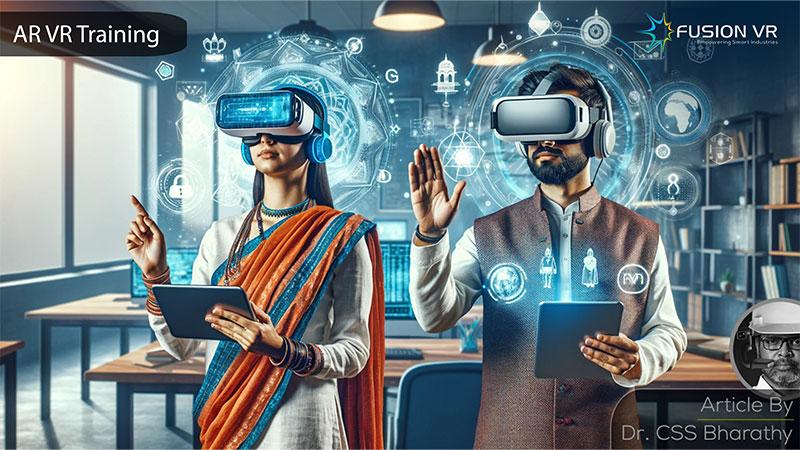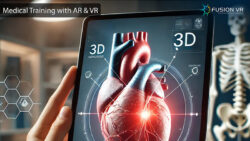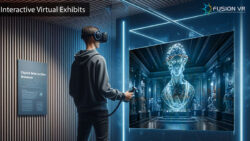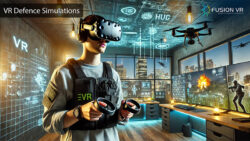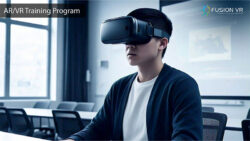The future holds great potential for those who are willing to learn and adopt new technologies in their quest to get better. This truism applies to individuals as well as nations. The field of Learning and Development has benefited from the use of technology since the advent of personal computers. From smart boards in classrooms, and students using laptops and tablets to the use of virtual reality (VR) and Augmented Reality (AR), technology deployment has indeed come a long way. It is not an overstatement that Augmented Reality and Virtual Reality technologies have emerged as revolutionary as well as transformative tools in the field of learning and development. This is crucial for organizations to adopt these technologies and provide their employees with the best and develop competitive advantages to compete in the marketplace. This is undoubtedly the future and adopting these wonderful technologies is crucial for survival and growth in the 21st century.
There are two stories here, one is the development of AR VR solutions for learning and development needs and the second is developing cohorts of young professionals towards becoming AR VR developers who can support the growing demand for such solutions. Let’s look at why AR VR training is going to be the future with some examples.
AR VR Training provides an Immersive Learning Experience.
The level of immersion and engaged learning is unmatched by traditional learning approaches. A research study from Stanford University reports that enhanced learning retention and engagement is enhanced when using AR VR training or learning. They found that participants exposed to immersive learning demonstrated a much higher level of knowledge retention. This is purely because AR and VR can effectively simulate experiences that are quite similar to a real-world experience. This experience develops stronger connections between the learner and the content being taught. Trainees often demonstrate better understanding and competencies with AR VR training. It is interesting to note that companies like Walmart are using VR training to simulate high volume holiday shopping experiences to improve employee confidence to handle such stressful scenarios and enable better preparedness. Such training is only possible with VR simulation training.
AR VR Training is Cost Effective
You may be tempted to ask how high technology solutions like AR and VR can be cost-effective. To understand that better, we need to look at what is needed to implement traditional training approaches. Typically, there are substantial costs involved in setting up the classroom infrastructure, training handouts, props, logistics and trainer availability. The need for qualified and experienced trainers is an important factor and often results in sub-par training delivered and learning objectives not achieved. Virtual reality and augmented reality training courses as reported in a PWC study could reduce training time by four times and improve employee performance by as much as 23%. When training duration is reduced, the cost of training is also substantially reduced. Additionally, it also allows more personnel to be trained, which results in earlier onboarding of a larger number of trainees to the designated positions. This becomes crucial in organizations which typically experience high turnover rates. Many companies and even governmental organizations have started to incorporate VR AR training courses into their existing training programs. The US Navy has understood the effectiveness of virtual reality training by using VR simulation programs to train their personnel on ship maintenance. This has contributed to not only an improvement in training effectiveness but more importantly a significant reduction in training costs.
Gaining skills needed to work in Hazardous Work Environments.
Many industrial environments involve different types of hazards that may injure personnel badly. It takes a considerable amount of training to safely execute their tasks. Developing the right competencies takes a lot of time and effort. It also requires experienced trainers to deliver this training in a traditional setting. Moreover, it’s not possible to visit the plant site and obtain hands-on training on the equipment. Virtual Reality training allows operators and technicians in refineries and chemical plants to gain the skills necessary to operate and maintain the facilities. This is accomplished with virtual reality simulators that recreate a simulated plant environment. It provides the ability to navigate and operate various types of equipment and control the processes to produce a desired product. The sights and sounds of a plant are recreated in a highly realistic environment that makes the trainee feel they are in an actual refinery unit. The VR Operator Training Simulator (VR-OTS) has been deployed in Industrial training institutions to equip students with the industry-specific knowledge and skills that enable them to obtain immediate employment and save the training effort needed once they join them as they already have the essential skills. This training is accomplished and the competencies are achieved without trainees getting into the hazardous work environment and not interfering with the ongoing production work.
Executing high-risk activities to perfection.
Many professions involve a certain degree of risk and they need to execute tasks with a high degree of precision to achieve the desired results. Many of these tasks can be found in the aviation, healthcare and manufacturing industries. Take hospitals for example, where critical procedures and operations need to be performed with high accuracy and following established safety protocols to deliver positive patient outcomes. Surgeons performing spine surgeries are now using VR training that simulates the surgery conditions on a virtual patient and allows the surgeon to practice the steps needed to be performed on a real patient. Surgeons gain the experience, confidence and skills needed for a specific procedure so that they can execute it with the highest accuracy. Similarly, AR simulators provide the instructions and data overlaid on the surgeon’s visual space to execute the procedure accurately. Such training benefits both the surgeon, the patient and the hospital establishment. Errors become fewer and so do medical malpractice suits, particularly in advanced economies.
Personalized Training Approaches.
AR and VR training lends the ability to personalize and customize training based on the needs of the individual. These training solutions can be designed or customized to suit the pace and manner of the training that is most appropriate for each learner. A very good example of this is practiced at Ford, the automotive giant where the assembly line training is tailored to match the individual technician’s skill level. This innovative approach using AR has helped Ford achieve a faster learning curve, saving time and money and also fewer errors during job execution.
Global participation in Training.
AR and VR solutions enable anyone from any part of the world to participate in and support a training effort. Remote assistance training enables an expert living in another country or time zone to oversee and provide input on a task that is being done. As industries use complex machinery, it is not possible to bring in OEM experts to the site and fix issues. Sometimes the training happens only when such machinery comes down for maintenance and AR helps provide the much-needed guidance and support. VR simulators are being designed to allow a technician to assemble and disassemble complex machinery virtually. This training when done repetitively helps the employee gain the knowledge and muscle memory to execute them in the future.
The Future of Learning.
It is quite easy to see how AR VR training is truly the future with the above mentioned examples, use cases and real life applications. It’s only a matter of time before these relay cool technologies become mainstream and a regular part of training design and execution. Fusion VR is a pioneer in the development and delivery of AR VR training solutions to the manufacturing sector in Asia. Our programs encourage the growth of AR VR developers through industry specific AR VR certification programs and courses partnered with leading institutions to enable the country to meet the demand for AR VR engineers. We are at the forefront of encouraging industry and academia to increase the adoption of AR VR training courses and develop a skills-based workforce ready to achieve their goals in the 21st century.

